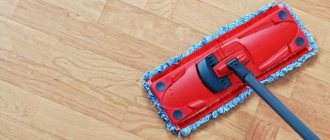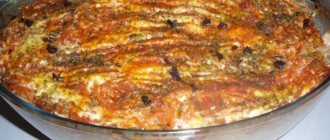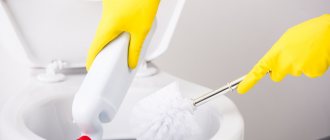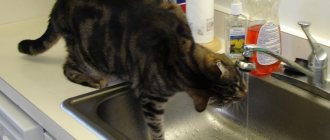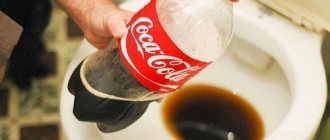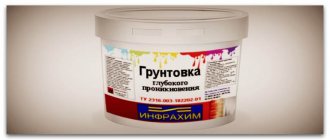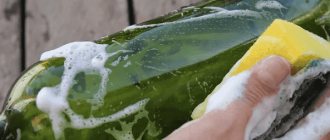Undoubtedly, many people like this drink. However, it is worth noting that tea, like coffee, is dark in color and has a coloring effect. For this reason, disgusting marks remain on the walls of tea cups, which spoil the appearance of the dishes. Moreover, they are quite difficult to remove. However, there are several effective and proven ways to easily remove plaque from this aromatic drink. Read more about them later in the article.
Causes
The leaves contain tannins. They give the drink bitterness and provide an astringent effect. Because of them, a cloudy film forms on the surface of the drink. It is not always visible, but over time it appears on the dishes.
When we drink, the mug tilts, a film settles on the cup and dries, becoming darker and thicker. This is the reason for traces that are difficult to wash off.
Is the raid dangerous?
Tannins, the pigments of which color dishes, are not only not dangerous, but are even beneficial for the body. Here are just some of the properties of tannins and catechins:
- They have anti-inflammatory and antibacterial effects;
- Strengthen the walls of blood vessels;
- Cleanse the body of toxins;
- Improves liver condition;
- They promote the release of the hormones dopamine and serotonin, which means they improve mood.
With excessive use, side effects occasionally occur:
- Abdominal pain, indigestion;
- Pressure surges;
- Decreased appetite.
Interesting: Why does the kettle make noise before boiling? Reasons, photos and videos
Tannins and catechins are found not only in black, but also in green tea. Moreover, their concentration is higher in it. This is one of the reasons why it is so useful. Tannins are also found in plants such as oak, chestnut, persimmon, cocoa, conifers, and bird cherry.
The stronger the tea you brew, the more likely it is that plaque will appear. Although it is not harmful to health, excessive consumption of caffeine contained in tea may not be beneficial. So if you regularly get plaque on the sides of your mug or glass, you might want to drink a weaker drink.
Interesting fact : in order for drinking tea to bring the greatest benefits, you should add lemon to it. This citrus improves the absorption of tannins, not to mention its other beneficial properties. It is also useful to add mint, lemon balm or thyme to tea.
Traditional cleaning methods
Tools that almost everyone has will help remove tea stains from your cup:
- lemon or citrus juice;
- toothpaste;
- Coca Cola;
- alcohol;
- salt;
- kefir or whey.
All methods of cleaning a mug do not require significant time investment - it will take a couple of minutes, no more. Let's figure out how to wash a cup using a specific method.
Citric acid and juice
To clean dishes from plaque, you need to take 1 tsp for 1 mug. products, add hot water and wait. After 5 minutes have passed, you can wash the cup. Citric acid works well to remove traces of tea on a mug.
Natural citrus juice is almost as effective. You need to cut off a slice and rub the mug with it, wait half an hour, then wash the cup. This method is used for minor contamination.
What else can I recommend?
Tea marks from the mug can be easily removed with bleaching dishwashing detergent. The instructions indicate that the product copes with even the most difficult stains. Apply the product first to the sponge and then to the mug. Next, you just have to rinse the dishes, waiting a while so that the product has time to react with the contamination.
Traces can also be removed using baking soda and water (one small spoon each). A paste is prepared from these components and applied to dark spots.
Some housewives prepare an effective cleaning scrub from salt or sugar.
Sand will also work. First, the mug is wetted and then wiped with salt. Next, you just need to wash the dishes.
You can also recommend using vinegar. Pour it into the cup until the container is half full.
Next, add boiling water and set the dishes aside for ten minutes. After this time, it remains to be washed using soap.
Use of household chemicals
With the help of special means, you can destroy tea stains in a cup without any effort. Even old stains are easily removed thanks to the presence of active ingredients.
The most persistent and thick plaque can be removed using concentrated Faberlic gel (lemon and mint) with bioenzymes. Soft consistency is another advantage of such products. The surface is not scratched, but is gently cleaned.
Popular products for removing tea stains are Pemolux and Comet. They are safe and versatile, used for cleaning the house. Pemolux is available in powder form and contains active ingredients.
About using the dishwasher
Judging by the reviews, many housewives are trying to remove tea stains by placing the dishes in this kitchen unit. And then after the procedure they are forced to admit that the traces could not be removed. There are several reasons for this. For example, the power of a dishwasher is not enough for this purpose. Most negative results are caused by a short cycle or the use of low temperature water. In this case, we can recommend trying to remove tea stains in different modes.
The machine will not cope with plaque if low-quality detergents are used, namely those that do not contain bleaches. In addition, according to experts, tea stains can be effectively removed only with products that contain phosphates. So, try replacing the detergents and most likely this problem will be resolved permanently.
Recommendations for caring for cups
- Wash your cup immediately after drinking tea or coffee. This will help so that the plaque does not have time to harden and the cup can be easily washed;
- Brew tea and coffee in teapots so that there is less residue on the cup;
- After all procedures, wash the cup with a regular detergent and rinse well under running water so that no odor remains, as some products can be toxic;
- Perform all procedures wearing rubber gloves to avoid an allergic reaction.
If you strictly follow all the tips written in this article, your favorite mug will have a very well-groomed and beautiful appearance for a long time.
The influence of water composition on the tea film
It is necessary to carefully select water for brewing tea. Why? Ordinary tap water has increased hardness and contains large amounts of iron and foreign impurities. After brewing with such water, a coating in the form of a film can very quickly form on the surface of the tea. After a few hours, the film becomes oily and more noticeable. It contains essential oils of tea with impurities.
What water is best to choose for brewing and why? The best option is spring water, but it is very difficult to find such a source and use it constantly. Bottled drinking water is more accessible and can be purchased at any supermarket. Distilled water will also work, as long as it is saturated with oxygen. When brewing with good water, the resulting layer on the tea drink will be almost invisible or there will be no film on the tea at all.
Toothpaste
Every toothpaste contains mild abrasives. Thus, it removes deposits well from our teeth, as well as from other surfaces that have become dirty. It will also remove coffee and tea deposits from cups and jugs.
You can apply the paste with a brush, but this is not necessary. You can also spread the paste with a regular dishwashing sponge (preferably the sharper side). All deposits disappear in the blink of an eye, and the mug only needs to be washed and rinsed thoroughly to enjoy its flawless appearance again.
Lemon juice or citric acid
Lemon juice and acid dissolve the sediment and prevent its formation. This is why this situation is less problematic if you drink tea with lemon. Then there is no tea residue, or at least less and easier to remove. However, not everyone prefers lemon to tea, and they don’t completely drink coffee with it.
In addition, acid or lemon juice can be successfully used to remove deposits from dishes. Minor stains should disappear without cleaning. It is enough to pour strongly acidified and hot water into the vessel for a few minutes.
Then simply wash and rinse the cups as usual. Older deposits may need to be treated with the sharper side of a scouring sponge, but we'll also do this effortlessly.
Chemicals to combat coffee or tea residues
Treating tea or coffee deposits with milk, powders and other ready-made cleaning products is a huge exaggeration and a waste of money. Not to mention the “ingenuity” of some housewives who pour other kitchen utensils, such as fabric bleach, into their favorite mugs.
This is not only a health hazard, but above all, it is simply stupid.
In the end, dirt can be removed without problems by using something that is completely safe and always at hand. We are talking about chemicals for kitchenware. After using it, be sure to rinse the dishes with plenty of water.
Author: Sergey Tumanov
Clinical researches
Clinical studies have proven that regular use of ASEPTA professional toothpaste improved the condition of the enamel by 64% and reduced tooth sensitivity by 66% after just 4 weeks.
Sources:
- Report on the determination/confirmation of the preventive properties of personal oral hygiene products “ASEPTA PLUS” Remineralization doctor-researcher A.A. Leontyev, head Department of Preventive Dentistry, Doctor of Medical Sciences, Professor S.B. Ulitovsky First St. Petersburg State Medical University named after. acad. I.P. Pavlova, Department of Preventive Dentistry
- Report on determining/confirming the preventive properties of toothpaste “ASEPTA PLUS” COFFEE and TOBACCO Author: doctor-researcher A.A. Leontyev, head Department of Preventive Dentistry, Doctor of Medical Sciences, Professor S.B. Ulitovsky. First St. Petersburg State Medical University named after. acad. I.P. Pavlova, Department of Preventive Dentistry
- Report on determining/confirming the preventive properties of toothpaste “ASEPTA PLUS” GENTLE WHITENING” Author: doctor-researcher A.A. Leontyev, head Department of Preventive Dentistry, Doctor of Medical Sciences, Professor S.B. Ulitovsky First St. Petersburg State Medical University named after. acad. I.P. Pavlova, Department of Preventive Dentistry
- Clinical and laboratory assessment of the influence of domestic therapeutic and prophylactic toothpaste based on plant extracts on the condition of the oral cavity in patients with simple marginal gingivitis. Doctor of Medical Sciences, Professor Elovikova T.M.1, Candidate of Chemical Sciences, Associate Professor Ermishina E.Yu. 2, Doctor of Technical Sciences Associate Professor Belokonova N.A. 2 Department of Therapeutic Dentistry USMU1, Department of General Chemistry USMU2
- Clinical studies of antisensitive toothpaste “Asepta Sensitive” (A.A. Leontyev, O.V. Kalinina, S.B. Ulitovsky) A.A. LEONTIEV, dentist O.V. KALININA, dentist S.B. ULITOVSKY, Doctor of Medical Sciences, Prof. Department of Therapeutic Dentistry, St. Petersburg State Medical University named after. acad. I.P. Pavlova
- The role of anti-inflammatory rinse in the treatment of periodontal diseases (L.Yu. Orekhova, A.A. Leontyev, S.B. Ulitovsky) L.Yu. OREKHOVA, Doctor of Medical Sciences, Prof., Head of Department; A.A. LEONTIEV, dentist; S.B. ULITOVSKY, Doctor of Medical Sciences, Prof. Department of Therapeutic Dentistry of St. Petersburg State Medical University named after. acad. I. P. Pavlova
Varieties
Nowadays, a large number of types of strainers have appeared. They all differ in material, shape, color.
The main materials used for the purpose of producing tea infuser are stainless steel and silver. However, they have a competitor - silicone, which has a number of valuable properties:
- The shape of the silicone product does not change over time.
- This material is heat-resistant.
- A high-quality product does not harm the human body.
- Silicone is very flexible, so it can be molded into different shapes.
Preventing tea stains on teeth
Tea lovers need to use a special whitening paste. A good option is to purchase ASEPTA PLUS, which provides gentle whitening and protection against plaque formation and unwanted pigmentation.
Advantages of ASEPTA PLUS paste:
- a unique multi-stage cleaning system that does not damage the enamel;
- content of potassium citrate and hydroxyapatite, which mineralize weakened enamel.
- calamus and eleutherococcus extracts strengthen the gums and help maintain healthy mucous membranes;
- Possibility of daily use.
Prevention of tea contamination
To prevent the formation of heavy deposits on cups after coloring drinks, you must follow simple recommendations:
- Try to wash dishes immediately after eating;
- To avoid damage to surfaces when cleaning mugs, it is necessary to prepare solutions from the following products: soda, salt, citric acid.
- Sponges, compared to rags, scrub the surface of dishes better, so it is better to give preference to them.
Important! Melamine sponges clean dishes well without damaging them. To clean mugs from tea deposits, you can use the hard part of such a sponge.
- Before you rush to clean your mugs every time, you need to determine the cause of the contamination. It happens that the dishes have a coating due to poor water quality. In this case, the dishes should be wiped dry immediately after washing.
- You should not leave a cup of unfinished tea. It is better to pour it out and wash the mug immediately after use.
